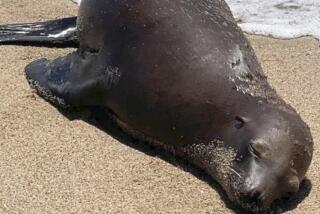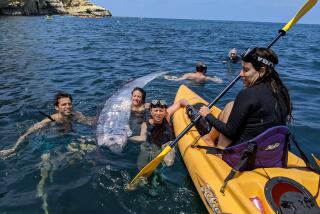Scientists Elated as Rare Shark Is Released in Sea : Marine life: Only the fifth megamouth ever found appears healthy. Implanted tramsmitters will track the animal.
DANA POINT â After more than a day in captivity, a mysterious species of shark--described as a living fossil--slipped back into the sea Monday after elated researchers videotaped it underwater and implanted radio transmitters to track its movements.
The 15-foot megamouth shark is the first to survive after being brought to shore, and the only one in the world to be filmed and studied alive, authorities said.
Caught accidentally in a fishermanâs gill net off Dana Point early Sunday, the bronze-colored fish with a cavernous jaw and bulbous head seemed healthy and strong when it was released a mile off Dana Point Harbor on Monday evening.
âI feel a bit sad to see him go, but Iâm really elated,â said Bob Lavenberg, an ichthyologist and curator of fishes at the Los Angeles County Museum of Natural History, who was first to identify the fish and coordinated the research.
âThis was an opportunity to get knowledge about a really rare fish and an opportunity to be environmentally sensitive at the same time by putting the fish back where he belongs,â Lavenberg said. âItâs the best of both worlds. He couldnât be better. And now we can get some real science done.â
One of the largest sharks in the world, the megamouth, with its large round head and whale-like appearance, is intriguing to scientists because its bizarre looks are so different from other sharks and extremely little is known about it.
The male caught Sunday, dubbed Mega, is only the fifth megamouth to be caught or found since the species was discovered off Hawaii 14 years ago. Researchers believe they can now glean enough information to better understand the exotic species.
Lavenberg described the shark as a âliving fossil,â a life form that has evolved slowly, deep in the ocean. âThis species is at least 10 million years old, and it has changed very little,â he said.
Underwater photographers working with the museum and the National Geographic Society were awed by what they saw, surfacing with vivid descriptions.
âWhen you swim right up to it, you know youâre seeing something different. It has gigantic eyes and big rubbery black lips,â said Michael de Gruy, who has been filming a documentary on sharks for National Geographic for two years. âItâs massive, with big, lumbering movements.â
The fish, which only eats plankton, seemed docile, letting divers touch it, even its mouth.
âHe would sort of flinch when people touched him, and his eyes would shift. When I swam to his side, he turned and looked at me,â said Mark Dellâ Aquila, an underwater photographer hired by the museum.
The ocean off Dana Point Harbor took on a carnival-like atmosphere as curious people and members of the media in boats encircled the shark, which was tied by its tail to the Moonshiner, the boat that caught it. Several people dived into the water for a closer look, while a noisy TV helicopter hovered above and jet skiers roared in close.
âWhat a circus!â Lavenberg said. âOnly in California can they turn this into a happening.â
Otto Elliott, a commercial fisherman and skipper of the 38-foot Moonshiner, said he caught the megamouth in his gill net about seven miles offshore about 2:30 a.m. Sunday while fishing for swordfish. He had to slice open his $5,000 net to keep the shark alive, but said he did so because he knew he had accidentally caught a rare, bizarre treasure.
A diver with a dart gun implanted two radio transmitters into the fish, which will tell scientists how deep and how far offshore it lives. A one-inch square of muscle was cut out of its hide near its dorsal fin so scientists can compare it with tissue from other well-known sharks to see how the species are related.
More to Read
Sign up for Essential California
The most important California stories and recommendations in your inbox every morning.
You may occasionally receive promotional content from the Los Angeles Times.










